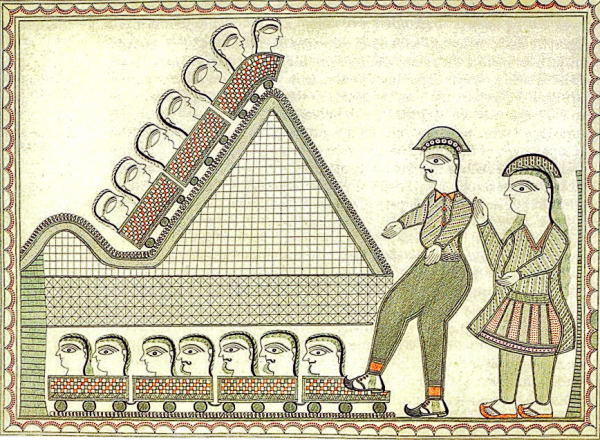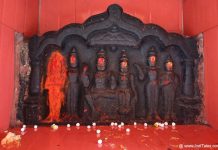Madhubani and Warli paintings have become the symbols of Indian tribal art or folk art. You can find them in the lanes of Delhi Haat, at Surajkund Mela, and at any fair that brings Indian artisans together.

Madhubani Paintings by Mithila’s Ganga Devi
These paintings became mainstream in the last 2-3 decades when they came out of the walls of village homes onto paper that could travel.
I had the opportunity to attend a course on Tribal Art by Prof Jyotindra Jain of JNU, New Delhi at Goa University. He told us the story of some of the tribal artists who kind of led this movement. Sharing the story of Ganga Devi who was one of the few women who pioneered the movement for Madhubani paintings.

Ganga Devi
Ganga Devi lived in a very small village in the Mithila region of Bihar. Abandoned by her husband for another woman since she could not conceive a child. In a domestic conflict, she lost all that she had to her co-wife. Her fate was not unique for the time and space she lived in.
Her destiny though was unique. It brought a French art collector to her doorstep, who gave her paper and asked her to do some paintings for them. The money he paid her was good enough for her to survive. Though for the art collectors, it would have been peanuts.
Slowly the demand for her work increased and she came into the view of museum curators in Delhi. They started inviting her to places like the Crafts Museum. She started working on commissioned pieces and the rest is history as they say.

Madhubani Paintings
Madhubani paintings were traditionally done on the walls of homes in rural areas of Mithila. These were ritual paintings called Kohbar that had defined iconography in specific colors done at events like weddings. For example, a bridal room where the bride and groom lived after marriage was painted with fertility signs like a bamboo plant or a lotus in full bloom.
There was a sense of sacredness attached to these wall murals. The paintings belonged to the women of the house. Who used to do these paintings and it is safe to assume that they all learned by observing the elder women in their families. There was obviously no formal training. Though some of them may have done more paintings than others as a result of circumstances or due to a personal interest in painting.

Traditional Paintings on Paper
Sometime in the 1960s, the Government of India decided to distribute free paper in these villages. That allowed these women to paint on paper rather than walls. The medium changed, the scale changed and the scope of subjects that can be painted became infinite. This sudden availability of a medium not explored until then unleashed the creativity of many women like Ganga Devi.
Many of them went on to become celebrated artists in their own way. However, as a legacy, they created an industry for the people of their region. You need to take a small walk in places like Dilli Haat or any crafts Mela to see the proliferation of Madhubani painters. What this means for the artists is recognition at national and international levels. More than that a means of employment for rural communities.

Ramayana Paintings by Ganga Devi
What did Ganga Devi paint – for she knew only how to paint the ritual murals? Well, we all grow up hearing the stories of epics like Ramayana. And this is what Ganga Devi painted in a series, along with other folktales that she must have grown up hearing.
Her paintings show a very controlled hand. Very neat & clean drawings, use of subtle colors – contrary to what we see in mass paintings. And brilliant use of space to show multiple scenes in limited space or to show the passage of time.

Manav Jivan (Human Life) series by Ganga Devi
Her other celebrated work is the Manav Jivan series. In these, she painted the life cycle of a rural woman. From the time of her birth to her attaining puberty, to her getting married, to her becoming pregnant and going through rituals. Giving birth to a child and rearing the child until the child starts another cycle of life.
She painted using the iconography required for the scene depicted, but she also experimented with what she chose to depict. Her paintings became a kind of documentation of the cultural fabric of the time and space. Capturing the nuances of protecting the child from the evil eye or eunuchs coming to perform after a child’s birth or offering prayers to the Kuladevata or the family deity.

Ganga Devi & USA
Her innovative works came when she traveled to Western countries like the USA. What she saw was very new to her and she translated that into a series of paintings. I really enjoyed some of her works from this series. As they are a great fusion of an Eastern folk art form and visuals from a Western society as Ganga Devi observed and internalized.
I remember seeing a similar work done by a Gond artist for a book, by Tara Books when he returned from London. Ganga Devi also did paintings of her other travels like her visit to Badrinath in Uttarakhand. She was awarded Padma Shri by the Government of India for her contribution to the arts.

Ganga Devi struggled with cancer and she painted a series on her dealing with the disease. However, she came out as a survivor and went back to her village to live. Apparently, she died a violent death at the hands of her step-son who probably wanted her newly acquired wealth.
Artists & Art Work
From where she began, she has obviously earned a lot, but it only meant building a pucca house in her village. Today, though her work is making many people wealthier. Her paintings now sell worth a fortune in the art market. Some of her wall murals can be seen at Crafts Museum, in Delhi.
Artists create works that gain value with time and age. Creating joy and wealth for every hand they pass through.














Lovely article about Gangs Devi and her life in art. Thanks for sharing the beautiful paintings and her life’s story too.
Its unfortunate that we do not know our own artists.
Yes that is very unfortunate but we are to blame as well as the government and other art institutes which only ask for art degrees before even seeing your work. Promoting our rural and tribal art and artists is not an easy job but it has to be done and you have taken the first step by highlighting them out here. Keep up the good work.
Lets all do it Aadil. Please share these stories with everyone you think would appreciate it.
Already shared this post.
Thank you so much Aadil
You’re most welcome, anytime!!!
Great post , Thanks for sharing
Happy that you liked it Rupam.
Very new article to me intact. Madhubani painting is very beautiful and it is appreciative to honor its painter . very well written
Thanks Yogi. Hope this post takes Ganga Devi’s story to some people and they would appreciate her work.
She no doubt was the doyen of such art and culture and took this to the global platform. But meeting apathy at home is no surprise for the way we value or treat such legendary works. You’ll perhaps be saddened by this :
http://timesofindia.indiatimes.com/india/Crafts-museum-renovation-wipes-out-famed-Madhubani-murals/articleshow/48893039.cms
Lets hope we learn to preserve and appreciate our heritage, art …
Thanks for an excellent piece and comprehensive information about one of the best Mithila Artists. I have created a petition on Change.or requesting the Ministy of Textiles to restore the murals destroyed as a result of renovation. We have crossed 260 mark on the petition signed by some if he leading artist including Bharti Dayal, national award winner. Daskar Chairman has also lent her support for restoration and has written a hard hitting piece in Indian Express which I had shared few days back.